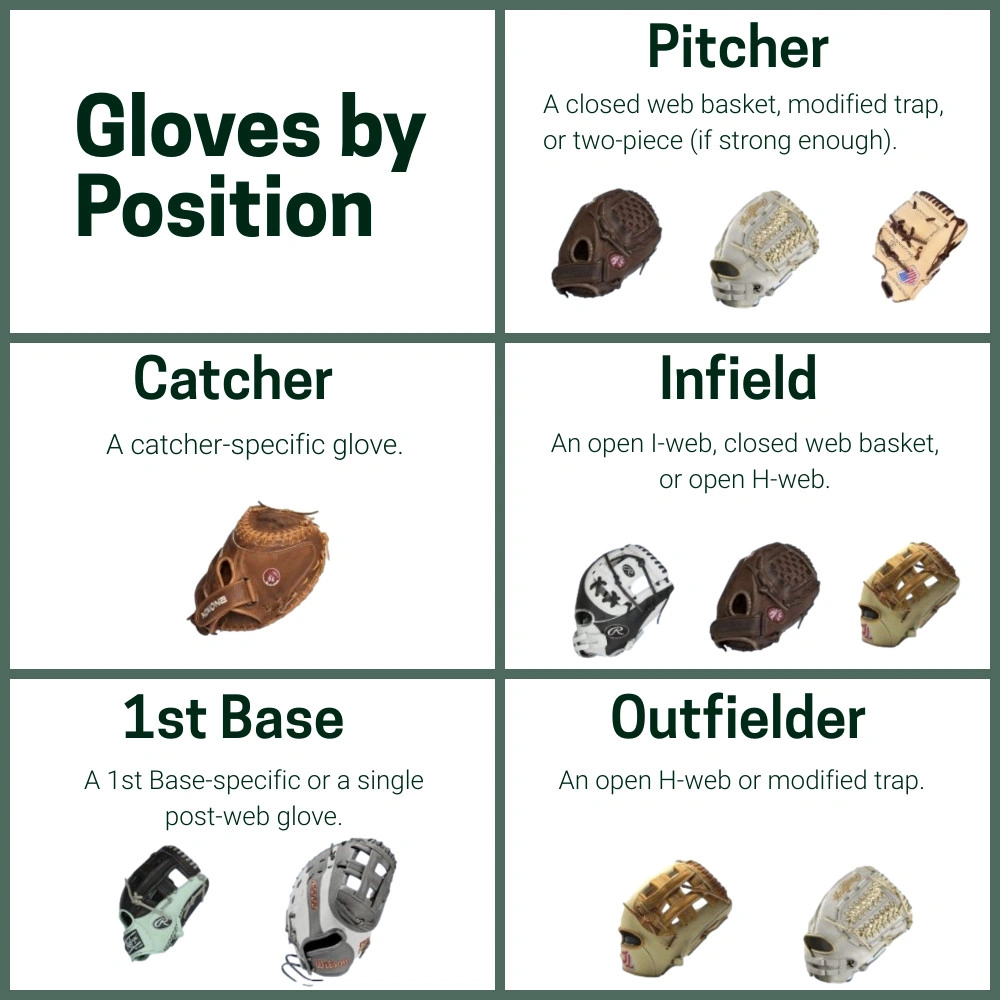Finding the Right Softball Glove
How do you pick the right softball glove?
There are so many factors to consider - the size, the design, the material and the color!
The right softball glove can make or break your game, so here’s a guide to the most important factors to consider when choosing your new softball glove.
Glove Anatomy
Anatomy is defined as the bodily structure or internal workings of an organism or object. In regards to human anatomy, it’s a complex topic that can help us better understand how and why we operate.
The anatomy of a softball glove is far less complex, but cannot be neglected in the glove selection process.
While each glove is unique, there are 5 components to each glove.
Pocket - The pocket is where you want to catch the ball. It connects the fingers to the thumb and helps absorb the impact and control the ball. Pocket size differentiates gloves and is used to determine gloves per position.
Heel - The lowest or bottom most part of the pocket designed to protect the heel of your hand.
Finger Stalls - The slots or openings for your fingers.
Palm - The portion over the palm of your hand with padding underneath to protect the hand on impact.
Webbing - Alongside the pocket, this is arguably the most important piece for ball control. It’s the portion closing the gap between the thumb and index finger.
There are 2 styles of webbing:
1. Open - Meaning there are holes or gaps in the webbing. Styles include:
-
I Web - An open webbing with 2 horizontal leather strips and 1 thicker vertical leather strip (making an I formation). The open webbing allows players to look through the webbing and the I shape encourages the ball to hit in the same place in the pocket for quick transitions. These are excellent gloves for infielders, specifically at the middle infield positions.
-
H Web - An open webbing with 2 vertical leather strips and 1 centered horizontal strip (making an H formation). H Webs also make great gloves for infielders, but the open webbing allows for easy viewing of fly balls so it’s also recommended for outfielders.
-
Single-Post Web - An open webbing with 1 large vertical leather strip and 1 large horizontal leather strip. Single-Post Web gloves have a deep pocket for securing hard hit and thrown balls but prevents quick transitions, which really makes it only suitable for 1st base.
2. Closed - Meaning there are no holes in the webbing. Styles include:
-
Basket Web/Complete Close - A completely closed web that does not allow any dirt or light through. These gloves are very popular in fastpitch softball at all positions, but are recommended for pitchers to help conceal their grip on the ball.
-
Modified Trap Web (Trapeze) - A vertical leather strip joined at the top by another horizontal leather strip. It allows for more flexibility and ease of closure. A Modified Trap Web makes a great glove for utility players because the flexible webbing makes for a great pocket for a variety of hit and thrown balls.
-
Two-Pieced Close - A completely closed web by 2 pieces of leather, which often leads to a heavier glove. These gloves are less popular in youth slowpitch and fastpitch softball simply due to their weight. They make great options for pitchers, but are most commonly used in older adult players.
There are two additional components that need to also be considered in assessment of glove anatomy:
Wrist Adjustment: The portion of the glove that allows for a truly individualized fit to your hand. Wrist adjustments can come in a variety of styles - velcro, lace, buckles and fasteners.
Back: The space for your index finger (if you choose to have it out of the glove). Similar to the webbing, there are 2 types of bacs:
1 - Open: A larger, open space designed for more flexibility and “give” during impact.
2 - Closed: A smaller hole designed to allow for more stability during impact.
How Do Slowpitch and Fastpitch Gloves Differ?
While all softball gloves are designed to catch the same sized ball (children’s gloves aside), the needs of each sport calls for slight differences in gloves.
Slowpitch is a sport of power, so the sport sees far more fly balls and line drives than fastpitch. It’s recommended that slowpitch players have a deeper pocket to make catching and trapping balls easier. Most players are recommended to have a glove also built for utility so they’re prepared to play a variety of positions.
Fastpitch is a sport of craft, speed and contact (power if you tee up the right pitch!). Athletes are recommended to use a glove with a smaller pocket in preparation for more ground balls and quicker transitions. Pitchers are encouraged to use a closed-web glove to hide their grip. Infielders can use either an open or closed web with a shorter pocket, while outfielders are preferred to have an open webbing with a deeper pocket. However, individuals at the youth level are encouraged to use a glove with a moderate sized pocket to solidify foundational skills and prepare for utility play.
What Materials Make a Softball Glove?
The anatomy and sizing of gloves create the largest difference from glove to glove, but does the material it’s made of matter?
YES!
Glove material impacts things like:
-
Flexibility (How much “give” does the glove have on impact?)
-
Durability (How long will the glove last?)
-
Comfortability (How does the glove feel on your hand?)
Gloves material can be broken down into 2 categories:
1 - Leather
2 - Synthetic
Leather gloves are the preferred choice of most slowpitch and fastpitch players. They are durable gloves that have more protection on impact and can last for several seasons. Unfortunately, these gloves take time and work to break in for your comfort.
There are different types of leather to consider before purchase each coming with their own pros and cons:
Full-Grain Hide Leather
-
Pros
-
A more affordable leather
-
Durable
-
Absorbs glove conditioners and oils well
-
Cons
-
A longer break-in process
Steerhide Leather
-
Pros
-
Durable
-
Strong gloves for heavy impact
-
Great absorbent of glove conditioners and oils
-
Cons
-
The heaviest glove for a player to support on their hand
-
A lengthy break-in process
Kip Leather
-
Pros
-
Lightweight & Breathable (Great for youth players!)
-
Great Mobility and Range of Motion
-
Short Break-In Process
-
Cons
-
Less strength to absorb heavy impact
Pigskin & Cowhide
-
Pros
-
Short break-in process
-
Affordability
-
Cons
-
Weight varies glove to glove (medium to heavy)
Synthetic gloves are made from a super lightweight material. These gloves grew in popularity for their affordability and because they are broken, ready-for-use at purchase. However, these gloves are known for being stiff and lacking in durability. Synthetic gloves are recommended for youth softball players who are going to outgrow gloves every 2 to 3 years.
Gloves by Position
Wouldn’t it be nice if you had a cheat sheet? One that told you what you needed for your position?
Check this out:

